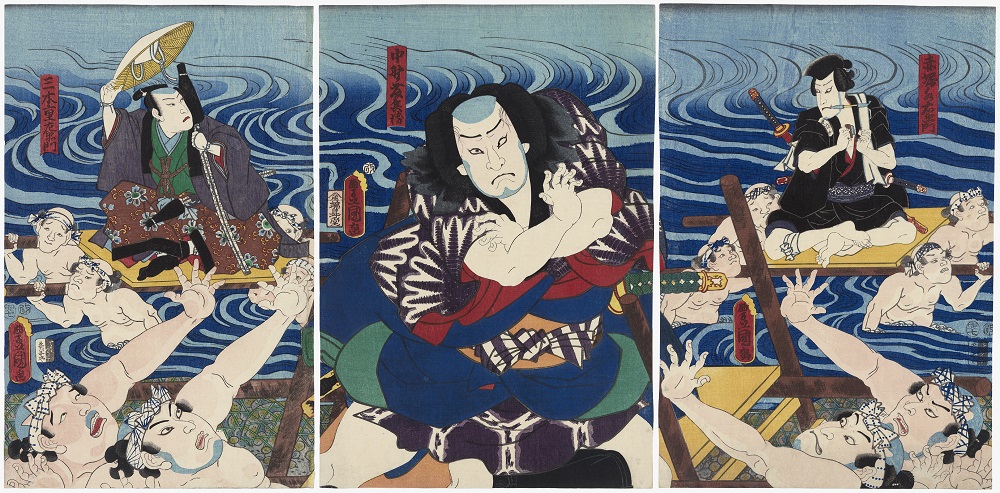
Two Japanese master printmakers are going head to head over on Huntington Avenue in Boston, MA.
In this corner—more accurately, on this wall—we have the work of Utagawa Kunisada (1786–1864), famous for realistic portraits of kabuki theater actors, sensual images of beautiful women, and the luxurious settings he imagined for historical scenes.
Hanging alongside are the works of Kunisada’s rival Utagawa Kuniyoshi (1797–1861), beloved by today’s connoisseurs and collectors for his dynamic action scenes of tattooed warriors and supernatural monsters—foreshadowing present-day manga and anime—as well as comic prints and a few especially daring works that feature forbidden political satire in disguise.
Now, after a visit to the Museum of Fine Arts to see Showdown! Kuniyoshi vs. Kunisada, let the battle of public opinion begin. Who is your favorite artist?
“They weren’t rivals in the way most people think of such things; they certainly didn’t hate each other,” explained Sarah E. Thompson, Curator of Japanese Art, who organized the exhibition. “They were natural rivals because they worked in the same medium at about the same time and they were both very popular. It’s fun to compare their work side by side, though, to see how both men created such different works using the same techniques.”
The artists shared more than just artistic mediums. Kuniyoshi and Kunisada were the star pupils of Utagawa Toyokuni (1769–1825), who was the second head of the famed Utagawa School of Ukiyo-e woodblock print artists. Ukiyo-e, which translates to “pictures of the floating world,” was a genre of paintings and prints that drew their subject matter from fashionable city life, especially the kabuki theater and the Yoshiwara pleasure district.
Kuniyoshi and Kunisada took the floating world by storm during the end of the Edo Period (1603–1868), when the mass-produced ukiyo-e prints thrived as an important media for conveying the latest entertainment and fashion reports—a precursor to television and magazines. Members of the public were thrilled and enthralled by the dashing heroes, beautiful women, and other figures portrayed within the works.
“They were both extremely prolific,” Thompson said. “There are about 10,000 Kuniyoshi prints and 20,000 to 30,000 Kunisada prints in collections today. They could do so many prints because they didn’t do the actual wood block printing. They drew the images then passed them on to professional carvers and painters who made the actual prints, which were then sold by the publisher.”
Like all popular culture figures, each artist’s fan base had specific reasons for supporting a particular artist. For example, those who patronized the theater were more likely to collect Kunisada’s portraits of actors and actresses.
“One of Kunisada’s strengths was to capture the likeness of the people he did portraits of, so if you were a fan of a particular kabuki star you would want his portrait hanging on your wall,” Thompson said.
Kuniyoshi’s fans were looking for something deeper from the art in their collection, such as slyly hidden humor or political commentary, whether it was there or not. In 1843, Kuniyoshi published The Earth Spider Generates Monsters at the Mansion of Lord Minamoto Yorimitsu—the subject was typical of his prints of warriors and monsters, but rumors quickly spread that it hinted discreetly at criticism of the current political situation. The print was banned and the blocks destroyed, but Kuniyoshi and his publisher escaped punishment because there was no clear proof of any wrongdoing. To this day, scholars argue about whether this work was a secret, illegal political cartoon.
“Kuniyoshi denied it in court,” Thompson said, but it helped make The Earth Spider Generates Monsters one of his best sellers.”
Showdown! Kuniyoshi vs. Kunisada will be on exhibit at the Museum of Fine Arts through Dec. 10, 2017.


